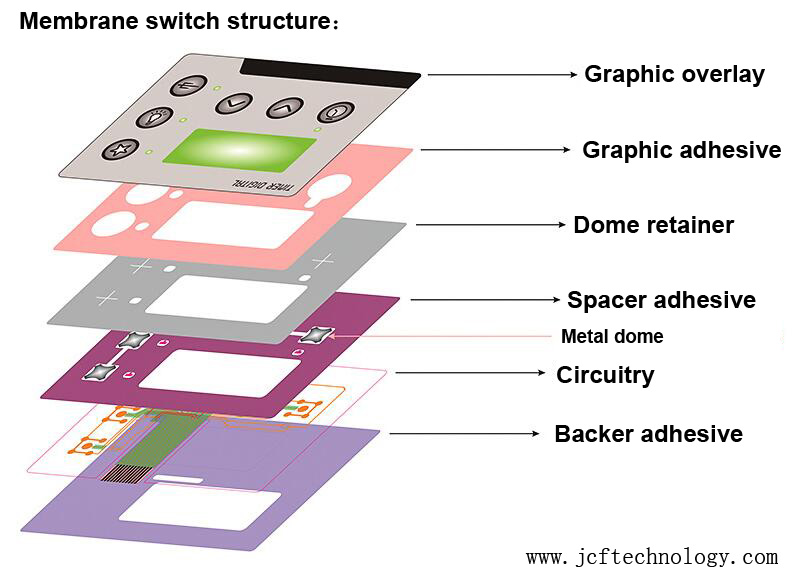Explore the Benefits of Using a Membrane Switch in Modern Devices
Explore the Benefits of Using a Membrane Switch in Modern Devices
Blog Article
Understanding Membrane Switches Over: The Key to Long Lasting and Reliable Controls

What Are Membrane Switches?
Membrane switches are an advanced service in the world of individual interface modern technology, incorporating capability and design seamlessly. These devices function as an interface between users and electronic systems, integrating a number of parts into a compact style. Normally constructed from adaptable, slim layers of products, membrane layer buttons are designed to respond to touch, allowing individuals to communicate with machinery and electronic gadgets successfully.
The main elements of a membrane button consist of a published circuit layer, graphic overlay, and a spacer layer that avoids unintentional activation. The graphic overlay can be tailored to mirror brand name identity or user choices, boosting aesthetics while ensuring use. Membrane layer buttons are typically utilized in numerous applications, consisting of medical devices, customer electronics, and industrial tools, owing to their longevity and resistance to ecological elements such as moisture and dirt.
One of the key benefits of membrane buttons is their capability to endure wear and tear, making them excellent for high-traffic atmospheres. Furthermore, they are light-weight and need very little area, enabling cutting-edge styles in product growth. On the whole, membrane layer changes represent a functional and efficient selection for modern digital interfaces, marrying modern technology with user-centric style concepts.
How Membrane Layer Switches Over Work
The procedure of membrane layer switches hinges on a basic yet reliable mechanism that equates individual input right into digital signals. When a user presses the switch, the top layer warps, permitting a conductive element in the circuit layer to make contact with a matching conductive pad on the bottom of the visuals overlay.
The layout of membrane layer switches can vary, but they typically include domes or responsive components to provide feedback to the user, enhancing the overall experience - membrane switch. The materials used in membrane switches, such as polyester or polycarbonate, add to their sturdiness and resistance to ecological aspects, consisting of wetness and dirt. The published circuits are normally encapsulated, which safeguards them from wear and tear over time.
Benefits of Membrane Buttons

Furthermore, membrane layer buttons are recognized for their resilience. Created from robust products, they are immune to dust, moisture, and physical wear, which substantially prolongs their lifespan contrasted to conventional mechanical switches. This sturdiness makes them especially appropriate for high-traffic atmospheres and applications calling for long life.
An additional substantial advantage is the simplicity of cleaning and maintenance. The smooth surface of membrane layer switches over lessens dirt build-up and is typically invulnerable to spills, making them optimal for settings that require constant sanitization.
In addition, membrane layer switches offer a structured account, resulting in a thinner design that can be incorporated right into various devices without including mass. This feature not just boosts the aesthetic appeal yet likewise contributes to an extra ergonomic product design.
Applications of Membrane Layer Switches
Straightforward and flexible, membrane layer buttons find applications throughout a vast array of sectors, including clinical gadgets, consumer electronic devices, and industrial tools. In the medical area, these switches are integral to gadgets such as diagnostic tools, individual monitoring systems, and mixture pumps, where reliability and simplicity of cleaning are essential. Their capability to withstand extreme environments and keep capability makes them optimal for such applications.

In consumer electronic devices, membrane layer switches are utilized in items like microwaves, washing devices, and remotes - membrane switch. Their streamlined design permits intuitive individual interfaces, boosting my latest blog post the total user experience while offering longevity and resistance to wear and tear
Commercial tools additionally takes advantage of membrane switches, particularly in control panels for machinery and automation systems. These buttons provide defense against dust and moisture, making sure regular efficiency in tough environments. Their customizable features allow manufacturers to tailor them to specific operational needs, enhancing look at this now performance and capability.
Picking the Right Membrane Layer Switch Over
When choosing a membrane switch, it is vital to think about various factors that affect efficiency and viability for particular applications. The primary considerations include ecological problems, responsive feedback, resilience, and design requirements.
First, examine the operating atmosphere; switches revealed to wetness, chemicals, or extreme temperature levels need particular materials to make certain durability and functionality. Next off, examine the need for responsive comments. Depending on customer interaction, some applications may gain from a tactile feedback to verify activation, while others may like a non-tactile design for visual factors.
Sturdiness is another critical aspect; membrane buttons ought to be made to stand up to frequent usage, impacts, and abrasion. Make certain the chosen button can withstand the expected lifecycle, especially in high-usage scenarios.

Conclusion
In final thought, membrane layer switches serve as crucial components in the style of trusted and durable control systems across different sectors. The versatility over at this website of membrane changes enables for customized remedies that meet specific operational requirements, strengthening their value in modern-day technology.
Membrane switches represent a vital element of modern-day user interface layout, mixing capability with strength in numerous applications.Membrane layer buttons are an innovative solution in the world of customer interface modern technology, combining functionality and layout seamlessly. Typically constructed from flexible, slim layers of products, membrane layer buttons are created to respond to touch, allowing individuals to connect with machinery and electronic tools properly.
The layout of membrane layer switches can vary, but they often include domes or responsive aspects to offer feedback to the user, boosting the general experience.In final thought, membrane switches over offer as vital components in the design of sturdy and trustworthy control systems across numerous markets.
Report this page